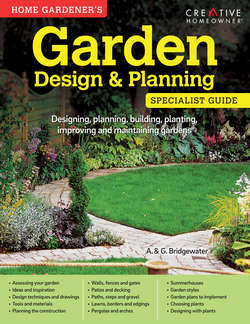Читать книгу Home Gardener's Garden Design & Planning (UK Only) - A. & G. Bridgewater - Страница 11
На сайте Литреса книга снята с продажи.
ОглавлениеTools and materials
Although you can borrow tools and use found, salvaged and gifted materials, such as old bricks and left-over sand, you will inevitably have to buy some new tools and things like cement and wood. Tools and materials come from DIY outlets, builder’s merchants and local suppliers. You can make savings in time and energy if you buy the best tools for the task, and in money if you purchase the materials in bulk from local suppliers.
What will I need to buy?
TOOLS
Measuring and marking
You need a basic kit for measuring, marking, checking levels and setting out the site. Spray paint or chalk can be used for marking out straight and curved lines (not illustrated).
Large tape measure
Tape measure
Pegs and string
Spirit (carpenter’s) level
Preparing the site
These tools will enable you to dig, move and level earth. You can hire (rent) a compaction plate (power tamper) for preparing large patio foundations (not illustrated).
Spade
Fork
Shovel
Sledgehammer
Rake
Gloves
Bucket
Wheelbarrow
Brick and stone
This toolkit will allow you to break, chop and cut both stone and brick. You may want to hire (rent) an angle grinder or a cement mixer for big projects.
(Stone) mason’s hammer
Club hammer
Bolster (brick) chisel
Bricklayer’s (mason’s) trowel
Masonry drill bit
Wood
If your designs include fences, gates, pergolas, sheds or decking you are likely to need the tools shown here.
General-purpose saw
Jig saw
Electric (power) drill
Cordless driver (drill)
Twist bit (for drilling holes in wood and metal)
Flat bit (for drilling holes in wood – not for metal)
Gardening
Apart from items like a spade, a fork and a pair of gloves, you may also need a mower and a small number of dedicated tools like those shown below.
Garden shears
Straight-bladed saw
Long-handle secateurs
Hand fork
Trowel
Secateurs
Hoe
Safety
Always follow the manufacturer’s instructions. Always protect your eyes, ears and hands when using power tools. Wear a dust mask when using cement powder. Wet cement is corrosive. Always keep children out of harm’s way.
MORE TOOLS
Often the best way of getting tools is to buy them when the need arises. For example, you have a spade and fork, but you soon find that you need a shorter, lighter spade, or a fork with a more comfortable handle, so you get another one. If you are less keen on the construction aspects, larger and/or more specific tools like a compaction plate (power tamper) or cement mixer are best borrowed or hired (rented). You could also borrow a few tools, and then buy your own when you know what it is about the borrowed tools that you like.
MATERIALS
Brick and stone
Brick and stone can be purchased direct from the producer, from builder’s merchants and from architectural salvage companies.
Concrete paving block
Selection of bricks
Flat stone
Rock
Building stone
Walling blocks
Cobblestones
Artificial stone paver
Imitation setts
Decorative gravel
Border tile
Edging and corner post
Buying earth and turf
Earth is best purchased by the cubic metre or yard in a giant bag or by the truckload. The more you get, the cheaper it will be. Be careful that you do not buy in poorer-quality stuff than you already have.
Turf is sold in rolled-up strips about 30 cm (1 ft) wide and 60–90 cm (2–3 ft) long. The cheapest way is to buy it direct from the grower. They are usually quite happy for you to pick up a small number of strips.
Concrete and mortar
While there are as many ‘best’ recipes as there are builders, the following work well. The numbers signify the ratio of ingredients (by volume) to each other, measured in the same manner (such as by the shovelful).
Concrete
3 aggregate + 2 sand + 1 cement
Mortar
3 sand + 1 cement
Wood
Wood in all its forms can be obtained variously from timber (lumber) yards, builder’s merchants, garden centres and specialist suppliers.
Useful wood sections
Trellis
Bark chippings
Log roll
Sleeper (tie)
Ponds and water features
All the items and materials needed for creating ponds and water features can be obtained from garden centres, water-garden centres and specialist suppliers. For large ponds choose a flexible liner. Geotextile is a soft textile material that is laid underneath flexible pond liners and helps prevent the liner from being damaged by sharp stones. A sump is often used in small water features.
Geotextile and flexible pond linings
Rigid liner (formal shape)
Rigid liner (informal shape)
Plastic sump
Rigid cascade liner
MORE MATERIALS
As garden design is becoming more and more popular, so many materials and products, such as decking, garden shelters, butyl pond liners and concrete sculpture, are being sold by dedicated specialist suppliers. The recent popularity of decking has meant that decking companies and companies only selling decking materials are springing up everywhere. You can make contact via local directories or by the internet; that said, however, one of the pleasures of garden design is travelling around searching out good suppliers.
